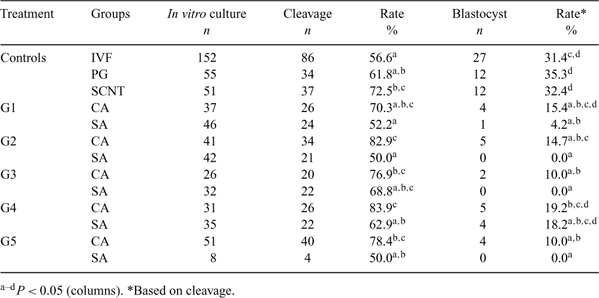47 EFFECT OF THE TYPE OF CYTOPLASTS, SOURCE OF KARYOPLASTS, AND ACTIVATION PROCESS ON IN VITRO DEVELOPMENT OF BOVINE CLONE EMBRYOS
L. U. Ohlweiler A , J. C. Mezzalira A , R. P. C. Gerger A C , E. S. Ribeiro A , F. Forell A , L. R. Bertolini A , J. L. Rodrigues B , C. E. Ambrósio C , M. A. Miglino C , A. D. Vieira A , A. Mezzalira A and M. Bertolini AA Center of Agroveterinarian Sciences, Santa Catarina State University, Lages, SC, Brazil;
B FAVET, Federal University of Rio Grande do Sul, Porto Alegre, RS, Brazil;
C FMVZ, University of São Paulo, São Paulo, SP, Brazil
Reproduction, Fertility and Development 21(1) 123-124 https://doi.org/10.1071/RDv21n1Ab47
Published: 9 December 2008
Abstract
As the recipient cytoplast plays a key role in nuclear reprogramming after somatic cell nuclear transfer (SCNT), the aim of this study was to compare the type of cytoplast/karyoplast [metaphase II (MII) oocyte, early zygote, somatic cells] and the chemical (CA) or sperm-mediated/spontaneous activation (SA) on in vitro development of bovine SCNT embryos produced by handmade cloning (HMC). After 17 h of in vitro maturation, a group of cumulus–oocyte complexes (COCs, n = 945) was manually bisected following zona removal and segregated as enucleated (MII hemi-Cyt) or non-enucleated (MII hemi-Kar). Another group of COCs was in vitro-fertilized, and, 4 h after the onset of IVF, zona-free zygotes with 2 polar bodies (n = 490) were manually bisected under fluorescent light to obtain IVF hemi-Cyt and IVF hemi-Kar. A somatic cell (SC) culture from an adult cow was used for HMC procedures (SC Kar). In 5 replications, experimental groups were composed of: zona-intact MII oocytes (parthenote control, PG); zona-intact zygotes (IVF control); MII Cyt + MII Cyt + SC Kar (SCNT control); IVF Cyt + MII Cyt + SC Kar (G1); MII Cyt + IVF Kar (G2); IVF Cyt + IVF Kar (G3); IVF Cyt + IVF Cyt + SC Kar (G4); and MII Cyt + MII Kar (G5). Following reconstruction and electrofusion, groups G1 to G5 were further divided into 2 sub-groups each, 1 being chemically activated (ionomycin/6-DMAP) along with the control groups PG and SCNT, whereas the others were cultured to verify sperm-mediated (G1 to G4) or spontaneous (G5) activation. Embryos were in vitro-cultured in the WOW system for 7 days. Cleavage (Day 2) and blastocyst (Day 7) rates were compared by the chi-square and Fisher tests, respectively. Cleavage rates in G1-SA, G2-SA, and G3-SA were lower than in their CA counterparts, which were similar to controls (Table 1). Such decrease in cleavage in G1-SA and G2-SA may be caused by the manipulation process rather than by sperm-mediation, since the observed rates were very similar to the G5-SA group. Cleavage in G3 and G4 were also similar to controls, most likely due to the fusion of 2 sperm-activated IVF hemi-Cyt. Blastocyst rates were generally higher in CA than in SA sub-groups except for G4, for which SA benefited from 2 sperm-activated cytoplasts. The lower blastocyst yield in SA sub-groups may reflect at least 2 possible mechanisms: an increased level of heteroplasmy (G1 and G2), potentially caused by an insufficient sperm-activated IVF hemi-Cyt or by a blocking effect imposed by the M-phase-derived hemi-Cyt, and/or a disruption in karyokinetic events caused by the manipulation in sperm-activated IVF hemi-Kar (G2 and G3). In G4, both mechanisms were probably attenuated by the use of 2 sperm-activated IVF hemi-Cyt and a SC-kar, analogous to conditions in the SCNT and G5 groups.

|
This study was supported by a grant from CAPES/Brazil.


